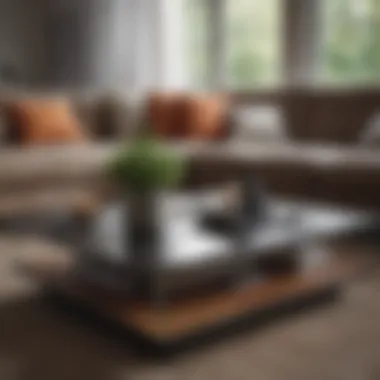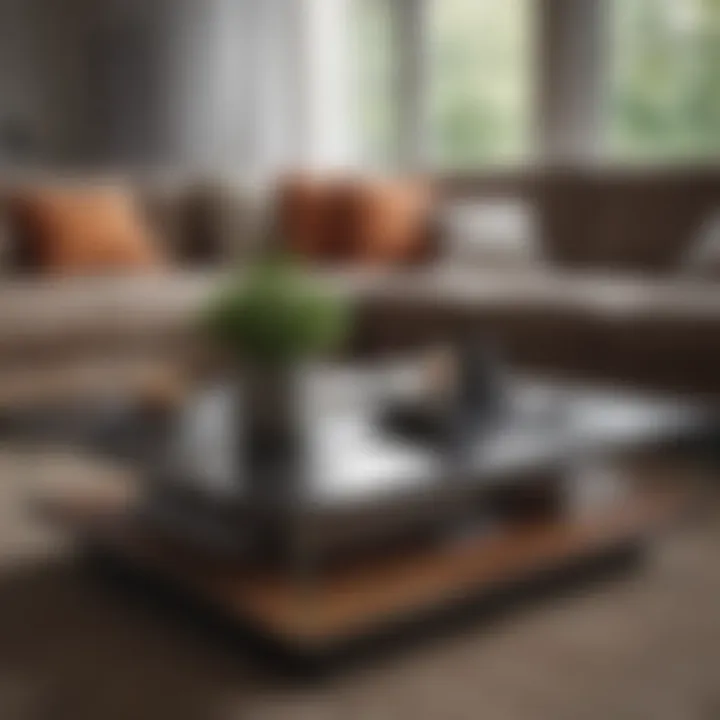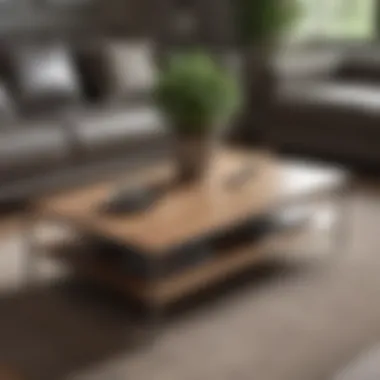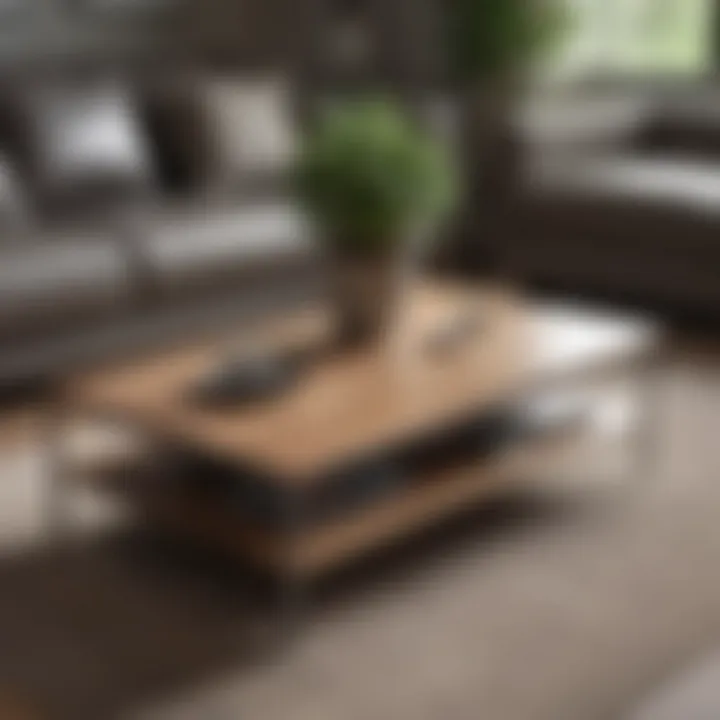How to Choose the Perfect Coffee Table Size for Your Sofa


Intro
Choosing the right coffee table for your sofa can significantly influence the overall aesthetic and functionality of your living space. This often overlooked piece of furniture serves not only as a visual anchor but also as a practical element in your lounge. Thus, understanding how to determine its size is essential for homeowners, decorators, and anyone seeking to enhance their living area. In this article, we will explore various aspects of selecting an appropriate coffee table size, such as room dimensions, sofa height, and design styles. By grasping these key concepts, you will be better equipped to make informed decisions that align with your personal taste and spatial requirements.
Design Inspiration
When assessing the right coffee table size, it's crucial to consider the design inspiration that underpins your space. The choice of style can significantly affect the dimensions of the table you select, ensuring that it harmonizes with the existing decor.
Current Interior Design Trends
The trends in interior design constantly evolve, but some themes consistently influence furniture choices. Minimalism remains popular, emphasizing clean lines and functional forms. In this context, a sleek, low-profile coffee table may work well. In contrast, bohemian styles tend to favor larger, more eclectic pieces that invite personalization.
- Focus on understanding the prevalent trends in your area.
- Consider how traditional styles like farmhouse can merge with contemporary aesthetics.
Color Palettes and Their Effects
The color scheme of your living area can also guide your decision on the coffee table size. Light colors tend to open up space, making smaller tables seem larger. On the other hand, darker hues can create a more intimate atmosphere and can work well with larger tables. It's advisable to choose colors that complement the sofa and surrounding decor.
"Size and color play crucial roles, but the table's shape should not be overlooked. Round or oval tables may offer more versatility in smaller spaces."
Understanding Coffee Table Dimensions
Understanding coffee table dimensions is crucial when selecting the right size for your living room. A coffee table serves as both a functional piece and a design element. It ties the room together while providing practical uses, such as holding drinks, books, or decorative items. By grasping the importance of dimensions, you can avoid common pitfalls that result in an awkward or cluttered space.
When discussing dimensions, several specific elements come into play. First, consider the overall size of the coffee table in proportion to the surrounding furniture, especially your sofa. An improperly sized table can throw off the visual balance and make the room feel uncomfortable. Additionally, proper dimensions ensure that the table serves its function effectively without hindering movement or access.
Another benefit of understanding coffee table dimensions is enhanced usability. A well-sized table can promote sociability during gatherings, making it easier for guests to place drinks or snacks within reach. This is particularly important for homeowners who frequently entertain. Lastly, proper dimension knowledge can lead to improved design coherence. Various styles and shapes can affect how the table fits seamlessly within the overall decor theme.
In summary, taking time to understand coffee table dimensions is essential. It improves functionality, increases comfort, and ensures a harmonious aesthetic. Start by familiarizing yourself with the specific sizes that work best for your space.
Standard Coffee Table Sizes
Coffee tables typically come in three standard sizes: small, medium, and large. A common small coffee table measures about 36 inches in length and roughly 18 inches high. This size fits well in compact living rooms or apartments where every inch counts. Medium tables often range from 42 to 48 inches in length, with a height of around 18 inches as well. This size fits a variety of sofas and gives a balanced look. Large coffee tables, generally exceeding 48 inches, provide significant surface area. They are ideal for spacious living areas or for those who desire a grand statement piece.
In addition to length, the width also affects how a coffee table interacts with the sofa. The width can range from 20 to 30 inches. This dimension contributes to how much space is available for items placed on the table.
Different Shapes and Their Impacts
Coffee tables come in various shapes, including rectangular, round, square, and oval. Each shape offers unique impacts on the space they occupy. Rectangular tables often suit long sofas and larger seating areas, enhancing spatial flow. Round tables facilitate easy movement around them, making them ideal for smaller rooms or crowded settings. Square tables can provide symmetry to the room, fitting nicely in spaces that mirror proportions. Lastly, oval tables blend the advantages of both rectangular and round designs, providing structural beauty in narrow spaces while remaining attractive.
The shape of the coffee table also influences interaction. For instance, round tables allow for a more casual feel during gatherings, encouraging conversation. On the other hand, a rectangular table might serve more formal purposes or provide a platform for items like magazines or decor.
Height Considerations
Height is a significant aspect when determining the right coffee table size. Most coffee tables stand between 16 to 18 inches tall, aligning closely with standard sofa seat heights. Ideally, the tabletop should sit about 1 to 2 inches below the seat cushions of your sofa. This height ensures comfort while reaching for items or engaging in conversation.
If the table height varies too much from this standard, it can create an uncomfortable experience. A table that is too low can make it hard to reach for drinks or books, while a table that is too high may obstruct sight lines or cause strain when bending over.
When in doubt, measuring the height of your sofa in relation to potential coffee tables will confirm a good fit. Consider also the height of other tables in the space. Maintaining similar heights across furniture helps with overall cohesion in the design.
Measuring the Space Available
Measuring the space available for a coffee table is a critical step in selecting the right size. This consideration is not only about ensuring that the table fits within the room but also in creating an environment that is both functional and aesthetically appealing. Taking precise measurements can greatly reduce the risk of purchasing a coffee table that is either too large or too small, causing issues in the overall layout and comfort of the living area.


Room Dimensions and Layout
The dimensions of the room play a pivotal role in determining the appropriate size for your coffee table. Measure the length and width of the area where the sofa and coffee table will be placed. Consider the shape of the room as well; a rectangular room may accommodate a different layout compared to a square room. This initial measurement allows you to visualize how much space is available without crowding the area.
Moreover, think about the arrangement of other furniture in the room. For instance, if you have additional seating or tables, you must factor that into your design. Aim for a balance where the coffee table complements rather than overwhelms its surroundings.
Sofa Size and Placement
The size of the sofa itself is another crucial consideration. A coffee table should generally be about two-thirds the length of the sofa for a harmonious design. When measuring, take into account the height of the sofa’s seat as well. A good rule of thumb is that the coffee table should be about the same height as the sofa seat or slightly lower. This uniformity in height facilitates ease of use when reaching for items placed on the table.
Additionally, the way the sofa is positioned in the room matters. If the sofa is pushed against a wall, the coffee table should be easily accessible. However, if the sofa is part of a conversation area, make sure the table is centrally located to promote interaction. The placement of the coffee table should encourage flow while being functional.
Traffic Flow and Accessibility
When selecting the coffee table, consider the pathways and accessibility within the room. There should be ample space to move around the coffee table without obstruction. The general guideline is to leave at least 18 inches between the sofa and the coffee table. This allows for comfortable legroom and easy access while sitting or standing.
Evaluate how traffic flows through the space. If guests frequently pass through the room, a low-profile coffee table might be beneficial. Conversely, if the table will be used mostly for decorative pieces, a taller table may serve your purposes well, as long as the traffic is not heavily obstructed.
Taking into account the room dimensions, sofa size, and traffic flow can significantly enhance your selection process. The careful approach ensures not only a pleasurable aesthetic but also a practical arrangement, conducive to relaxed living.
Proportionality and Balance
Understanding proportionality and balance is crucial when selecting a coffee table. These elements ensure that your living space feels harmonious and inviting. If the coffee table does not match the sizes of both the sofa and the room, the overall decor can appear awkward. Achieving the right proportions creates a sense of cohesion and comfort.
Visual Balance with Sofa
When determining the right coffee table size, visual balance with your sofa is vital. The coffee table should not overpower or appear dwarfed by the sofa. Generally, a table should have a height that is proportionate to the height of the sofa cushions. This typically means that the coffee table should be between 1 to 2 inches lower than the seat height of the sofa.
For example, if your sofa has a seat height of 18 inches, aim for a coffee table height between 16 and 17 inches. A well-chosen coffee table enhances the overall aesthetic of the space, offering a comfortable interaction area without disrupting the visual flow.
Complementing Room Proportions
Room proportions play an equally important role in establishing balance. A larger room can accommodate a more substantial coffee table, while a smaller room may benefit from a more compact piece.
Consider the following factors:
- Scale of Furniture: Ensure that there is a balance in size among all pieces. A large sofa deserves an appropriately sized coffee table.
- Spacing Around the Table: Leave sufficient space around the coffee table for ease of movement. Standard recommendations suggest a distance of 18 inches between the table and seating choices to allow for comfortable passing.
- Ceiling Height: In rooms with high ceilings, larger tables may create a more grounded feel. Conversely, in lower ceiling spaces, smaller tables can keep the area feeling open.
All these aspects contribute to harmonious proportions within the room, which is essential for making the living area enjoyable.
Creating Cohesion with Other Furniture
Cohesion between the coffee table and other furnishings promotes a unified design aesthetic. The coffee table should align with the style and color of the sofa, as well as other furniture pieces in the room.
Here are some tips for achieving this:
- Matching Materials: Wood coffee tables work well with wooden furniture, while glass can create a modern feel against soft fabrics.
- Color Coordination: Choose hues that either match or complement existing furniture. This can mean selecting a table that highlights an accent color from your upholstery or drapes.
- Design Style: Whether contemporary, traditional, or eclectic, the coffee table should align with the overall design style of the room.
Cohesion is especially important in open floor plans where multiple areas blend into one another. By ensuring that the coffee table works with other furniture, you create a seamless, inviting environment.
Style and Functionality
When determining the size of a coffee table, style and functionality play crucial roles in the overall cohesion of your living space. The coffee table is not just a piece of furniture; it serves as a central point in your living area, influencing both aesthetic appeal and usability. In this section, we will explore how the right coffee table can balance design with practical use, ultimately enhancing your home environment.


Aesthetic Considerations
A coffee table's style has a significant impact on the overall look of a room. It can either complement or contrast with other furniture pieces. When selecting a coffee table, consider the existing color palette and design style of your sofa and the entire room. A sleek glass or metal table might suit a modern setup, while a rustic wooden table may work better in a traditional space.
Moreover, the shape of the table can influence visual dynamics. Round tables adapt well in smaller areas, allowing for easier traffic flow, whereas rectangular tables provide a more formal look, filling larger spaces effectively. There are also detailed aspects to reflect upon, such as textures and finishes, which need to harmonize with the upholstery of your sofa. Pay attention to how the colors interact. For example, a dark sofa may benefit from a light coffee table to create contrast and vice versa.
Practical Uses of Coffee Tables
Functionality is equally vital. Coffee tables serve various purposes beyond aesthetics. They can be used for placing beverages, books, or decorations. Additionally, many designs include storage options, adding to their versatility. Choose a table that meets your specific needs.
- Serving Surface: Ensure the table is of adequate size to serve snacks during gatherings or to hold items you regularly use, like remotes or books.
- Storage: If you often require extra space for magazines or blankets, a coffee table with drawers or shelves should be considered.
- Multi-Functionality: Some tables can convert into dining surfaces or have extendable features, which can enhance their practical value in small spaces.
Versatile Designs for Various Needs
Coffee tables come in various designs that can cater to different lifestyles. Therefore, it is essential to assess what you need in terms of style and functionality. Depending on your circumstances, different features may be more valuable.
- Families with Kids: Consider coffee tables with rounded edges or durable surfaces that resist scratches and spills. These tables can withstand everyday wear and tear, making them practical for homes with young children.
- Entertainers: If your home is often a gathering place for friends and family, opt for larger tables that can hold more items, or feature a design that allows easy movement across the table.
- Minimalist Living: For those favoring a clean, uncluttered space, minimalist coffee tables offer sleek designs without excessive adornments. Look for tables with storage to keep surfaces tidy and organized.
Color and Material Choices
Selecting the right color and material for a coffee table is a critical aspect of interior design. The coffee table not only serves a functional purpose but also plays a significant role in the aesthetic composition of a living space. A well-chosen coffee table can enhance the overall ambiance, pulling together various elements of decor.
Matching with Sofa Fabric
When choosing the color and material of a coffee table, it is essential to consider its compatibility with the sofa fabric. The harmony between these two furniture elements can significantly influence the room's visual appeal. For instance, if the sofa is upholstered in a bold pattern or vibrant hue, opting for a more neutral coffee table can create a sense of balance. Conversely, if the sofa is understated, a coffee table with a pop of color can become a focal point.
Textures also matter. A smooth, glass coffee table may not complement a plush, fabric sofa. Instead, materials like wood or rattan can bring warmth and cohesion to the space, tying in with the soft textures of the sofa.
Durability and Maintenance of Materials
Another consideration when selecting a coffee table is the durability and maintenance needs of the chosen materials. For high-traffic areas, it is advisable to select materials that withstand daily use and wear. Solid wood tables are robust and can age beautifully, making them a long-lasting choice.
Glass tops can look elegant but require regular cleaning to maintain their clarity. Alternatively, materials like metal can offer a modern feel and require minimal upkeep.
Durability should not compromise style. Ultimately, a balance between aesthetic appeal and practical function is crucial when deciding on the coffee table material.
Trends in Color Coordination
Understanding current trends in color coordination can also guide your coffee table selection. Earthy tones, such as terracottas or muted greens, are gaining favor as they create a calming environment. Incorporating a coffee table that echoes these tones can enhance the unity of the room.
Similarly, monochromatic looks are popular, wherein different shades of a single color are used throughout the space. This can create a sophisticated and cohesive appearance.
Furthermore, metallic accents are becoming popular, adding a touch of luxury. A coffee table with a brass frame, for instance, can contrast beautifully against a plush sofa fabric.
In summary, when evaluating color and materials for a coffee table, consider how they align with the sofa fabric, assess durability requirements, and keep an eye on contemporary trends. These factors together ensure that your choice is not only practical but also enhances the visual harmony of your living space.
Evaluating Personal Needs
Determining the right size coffee table requires considering personal needs. This process is crucial because the coffee table is not just a piece of furniture; it serves various functions depending on individual lifestyles and preferences. A table can be a centerpiece for gatherings, provide storage, or support day-to-day activities. Understanding one’s specific needs ensures that the choice made aligns with the practical and aesthetic goals of the living space.
Lifestyle Considerations
Lifestyle plays a major role in choosing the ideal coffee table size. For example, an individual who frequently hosts guests may require a larger table to accommodate snacks and beverages. A wide surface area can facilitate ease of access and create a social atmosphere during gatherings. On the other hand, a minimalist lifestyle may favor a smaller, more discreet table that does not dominate the visual space. Adjustable features may also appeal to those who like flexibility; moveable tables can adapt to various situations. In essence, evaluating how often the space will be used and for what specific activities can guide in selecting the appropriate size.


Family Dynamics and Usage
Family dynamics influence how a coffee table will be utilized. For families with children or pets, durability and safety become prime considerations. A robust coffee table made from sturdy materials might withstand wear and tear better than delicate designs. Size matter too; a larger table allows for games and crafts but it should still not obstruct movement in the space. In addition, families who come together for activities should ensure the table fits comfortably in their routine. Assessing how the coffee table will support or hinder these interactions can lead to a more thoughtful decision.
Future Adaptability
Future adaptability is an essential aspect of evaluating personal needs. Homeowners should consider how the coffee table will fit into the evolving landscape of their lives. As families grow or change, the requirements for living spaces may shift. A coffee table that can serve multiple purposes, such as providing extra storage or transforming into a larger size, will maintain its relevance as situations change. This foresight in planning can save individuals from needing to replace furniture often, ultimately making a more economical choice. Thus, reflecting on how personal needs may change over time should be a key part of selecting the right coffee table.
Practical Test Methods
When selecting the right coffee table size for your sofa, practical test methods are essential. They provide an experiential approach, allowing you to visualize and assess how various dimensions blend with your existing furniture and layout. The key elements in this area include mock-ups, adjustments for comfort, and gathering feedback from others in the space. Each aspect contributes to making informed decisions that enhance functionality and aesthetics in your living area.
Using Mock-ups
Creating mock-ups of potential coffee table sizes gives a clearer perspective of how the table will coexist with the sofa. You can use tape on the floor to outline the dimensions of different tables. This technique offers a dimensional representation that helps visualize space and aesthetics.
Measure the height of the mock-up in relation to your sofa. Ideally, the top of the coffee table should be no more than a few inches higher than the seat of the sofa. This allows for easy access without complicating movement around the room. Using objects of similar height, such as boxes or cushions, can help you gauge how different sizes will feel in the context of your living area.
Adjusting for Comfort
After establishing mock-ups, it’s crucial to evaluate them for comfort and practicality. Sit on your sofa and imagine using the coffee table. Consider how easy it is to reach items on it from a seated position. The coffee table should facilitate movement while accommodating activities such as dining or placing drinks and magazines.
Test various heights and sizes by shifting your mock-ups closer or farther from the sofa. To achieve comfort, ensure ample legroom and unobstructed pathways for guests. Understanding how your coffee table interacts with the sofa enhances its practical usage, enabling smoother functionality during gatherings or personal downtime.
Feedback from Others in the Space
Gaining feedback from family members or friends who share your living space is vital. Different perspectives can illuminate considerations you might not have thought of, such as usability or aesthetics. Invite others to sit on the sofa and engage with your mock-up setup. This interaction allows for valuable insights regarding dimensions and comfort levels.
Sometimes, a collaborative approach leads to the best solutions.
"Inclusivity in design choices can profoundly enhance your overall satisfaction with living space arrangement."
Discuss their thoughts on size, height, and placement ideas. Consider their responses seriously; the table is for shared experience, so it's important that it meets everyone's needs.
Final Considerations
When selecting the right size coffee table for your sofa, careful thought about final considerations is paramount. This part focuses on consolidating all the information gathered and making definitive choices that ensure both aesthetic appeal and functional integrity. Final considerations incorporate key elements such as spatial harmony, furniture usability, and long-term satisfaction. By engaging in this thought process, homeowners will be better equipped to create a cohesive and inviting living space.
Making a Decision
In the decision-making phase, one must synthesize the previously analyzed dimensions, proportions, and styles. Assess how the coffee table size complements the existing furniture. The coffee table should neither dominate nor be lost in the room. Consider measuring the distance between the sofa and the table; a range of 15 to 18 inches is often recommended. This spacing allows for comfort while maintaining a cohesive look.
Take notes on the styles preferred prior to shopping. Styles can range from contemporary to rustic. Each can affect the perception of size and space. A glass table may appear larger than a wooden one due to its transparency. Knowing what you truly want will aid in making a confident choice.
Purchasing Tips
With a decision in place, purchasing becomes the next step. When shopping for the ideal coffee table, prioritize quality. Good materials can save you from future problems. Here are some purchasing tips:
- Test Stability: Ensure the table does not wobble when pressed.
- Check for Finish: Make sure the surface is smooth and free from defects.
- Consider Shipping and Assembly: Know if the item requires assembly and understand the delivery fees if applicable.
- Warranty Information: Review any warranties for protection against defects.
These suggestions can help safeguard your investment, providing you with options that retain their value over time.
Post-Purchase Adjustments
Once a coffee table is purchased and placed in your space, some adjustments may be necessary. Initial positioning might not be perfect. You should be open to making changes to find the most comfortable arrangement.
- Re-evaluate the Placement: Is there enough space for movement? Can the table serve its intended purpose?
- Consider Additional Styling: Adding decorative elements such as books or trays can impact height perception.
- Gather Feedback: Involve family or guests for their input on functionality and comfort.
Adapting the arrangement after purchase can lead to a more satisfying experience in your living room. Comfort and practicality should go hand-in-hand with your coffee table choice, ensuring it serves your lifestyle well.















